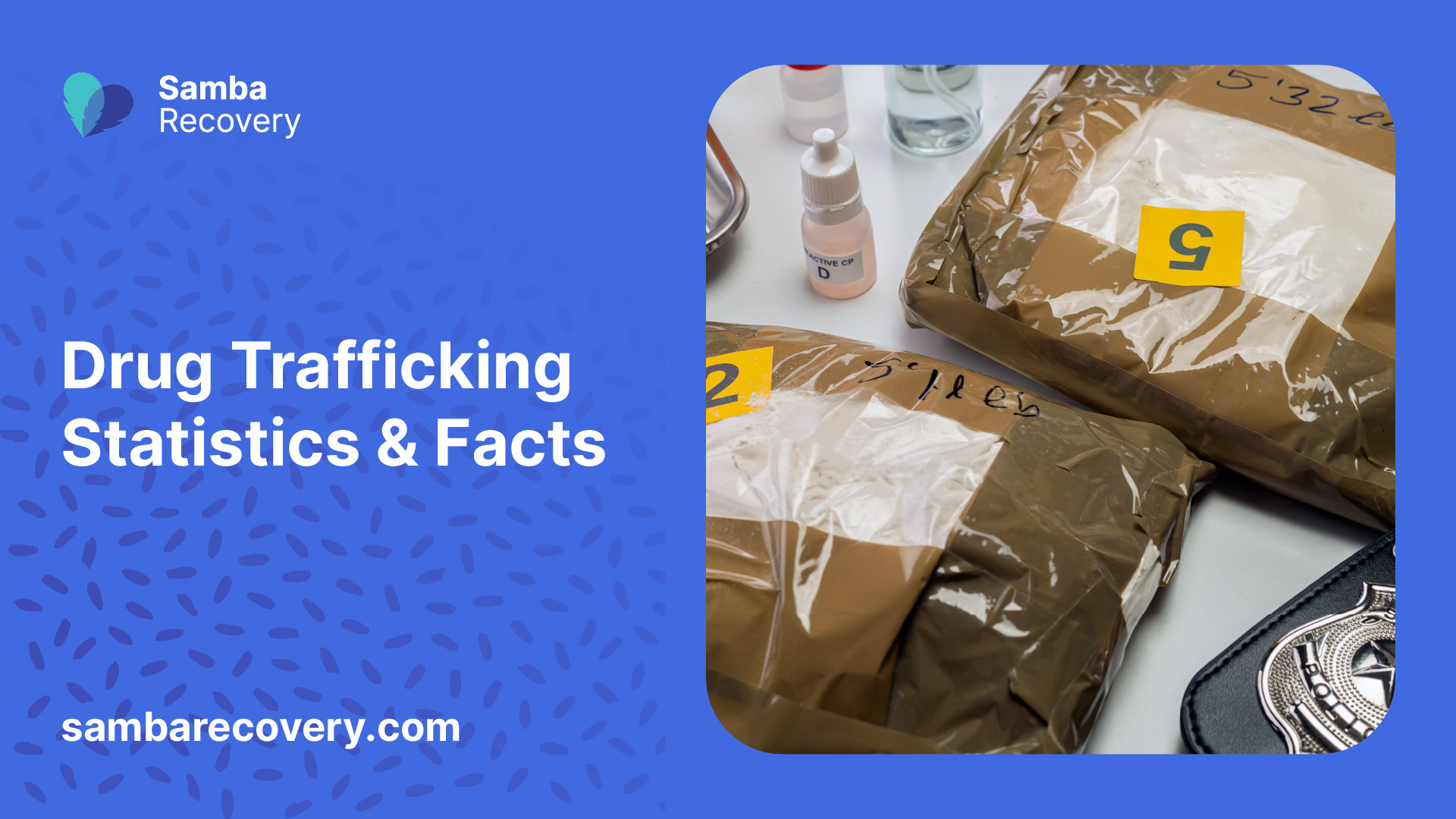Top 10 Key Drug Trafficking Statistics and Facts
Here are the top 10 key statistics about drug trafficking:
- The global illegal drug industry is estimated to be worth between $426 billion and $652 billion per year.
- The United States illegal drug industry is estimated to be worth between $200 billion and $750 billion per year.
- Drug abuse costs society an estimated $181 billion per year in healthcare costs, lost workplace productivity, law enforcement, and legal costs in the United States.
- In 2012, there were 330,000 prison inmates incarcerated for drug offenses in the United States, with over 30 percent of all offenses in 2013 being related to drug trafficking.
- Mexican drug cartels make an estimated $19-$29 billion a year from drug sales in the United States.
- The conflicts between Mexican drug cartels and law enforcement officials have resulted in over 55,000 deaths since the beginning of the Mexican Drug War in 2006.
- The U.S. Drug Enforcement Administration (DEA) has seized almost $30 billion in revenue from drug traffickers between 2005 and 2014.
- Afghanistan is not only a source for cannabis but also an active transshipment point for Albanian narco-trafficking organizations moving illicit drugs into European markets.
- Both Algeria and Angola are used as transshipment points for cocaine destined for Western Europe and other African states, particularly South Africa.
- World heroin consumption (340 tons) and seizures represent an annual flow of 430-450 tons of heroin into the global market.
These statistics and facts illustrate the complex and ongoing issue of drug trafficking, particularly in relation to the United States and Mexico.
Understanding Drug Trafficking
Drug trafficking is a global and multifaceted issue, impacting societies on various fronts, including health, governance, security, and sustainability. To fully comprehend the scope and impact of drug trafficking, it’s essential to delve into the latest drug trafficking statistics & facts, as well as understand the dynamics of the global drug market.

Global Drug Market Overview
The illegal drug industry is a vast and complex system, spanning across numerous countries and affecting millions of people worldwide. According to the World Drug Report 2023, this industry is continually evolving, with new estimates of drug demand, supply, and trafficking trends being documented [1].
The United States, in particular, has a substantial illegal drug industry. Current estimates suggest that this black market industry could be worth anywhere between $200-$750 billion per year. This decade has seen the largest per person drug usage per year in American history [2].
| Region | Estimated Value of Illegal Drug Industry (per year) |
|---|---|
| United States | $200 – $750 billion |
Impact of Drug Trafficking
The impact of drug trafficking is far-reaching, affecting not only individuals but also communities, economies, and societies as a whole. In the United States, drug abuse costs society an estimated $181 billion per year in healthcare costs, lost workplace productivity, law enforcement, and legal costs.
In addition to the economic costs, drug trafficking also contributes significantly to crime rates. In 2012, there were 330,000 prison inmates incarcerated for drug offenses in the United States. Over 30 percent of all offenses in 2013 were related to drug trafficking.
| Impact | United States |
|---|---|
| Annual societal cost of drug abuse | $181 billion |
| Prison inmates incarcerated for drug offenses (2012) | 330,000 |
| Percentage of all offenses related to drug trafficking (2013) | 30% |
The World Drug Report 2022 also highlights the nexus between drugs and environmental sustainability, focusing on the impact of the world drug problem on climate change and environmental sustainability [3].
As the data suggests, drug trafficking is a pervasive issue with wide-reaching implications. The following sections will delve into more specific drug trafficking statistics and facts, further elucidating the impact and scope of this global problem.
Drug Trafficking Statistics
The following section presents key drug trafficking statistics and facts, focusing on the United States drug industry, Mexican drug cartels, and U.S. DEA seizures.
United States Drug Industry
The illegal drug industry in the United States is a substantial black market trade, estimated to be worth between $200-$750 billion per year. The last decade has witnessed the highest per person drug usage per year in American history.
The societal cost of drug abuse is significant, amounting to $181 billion per year. This figure encompasses healthcare costs, lost productivity in the workplace, law enforcement, and legal costs.
In 2012, there were 330,000 prison inmates incarcerated for drug offenses in the United States, with over 30 percent of all offenses in 2013 being related to drug trafficking.
Mexican Drug Cartels
Mexican drug cartels are a significant player in the drug trafficking industry, making an estimated $19-$29 billion a year from drug sales in the United States. The conflicts between these cartels and law enforcement officials have resulted in over 55,000 deaths since the beginning of the Mexican Drug War in 2006.
U.S. DEA Seizures
The U.S. Drug Enforcement Administration (DEA) has made substantial progress in combating drug trafficking, having successfully seized almost $30 billion in revenue from drug traffickers between 2005 and 2014 [2]. This figure demonstrates the significant resources and efforts dedicated to the fight against drug trafficking, although the ongoing challenge is evident in the high value of the illegal drug industry.
These statistics and facts illustrate the complex and ongoing issue of drug trafficking, particularly in relation to the United States and Mexico. They underscore the need for continued efforts in law enforcement, policy, and public education to mitigate the impact of drug trafficking on society.
International Drug Trafficking
The global landscape of drug trafficking is complex and far-reaching, impacting every corner of the world. This section explores the roles and impact of drug trafficking in Afghanistan, Algeria, Angola, and Argentina, shedding light on the global reach of this illicit trade.
Afghanistan’s Role
Afghanistan plays a significant role in the international drug trade. The country is not only a source for cannabis but also an active transshipment point for Albanian narco-trafficking organizations moving illicit drugs into European markets. These activities contribute to the global drug trafficking problem, posing significant challenges for international security and law enforcement.
Trafficking in Algeria and Angola
Both Algeria and Angola are used as transshipment points for cocaine destined for Western Europe and other African states, particularly South Africa. This strategic location makes them crucial players in the international drug trafficking network, underscoring the global nature of this illicit trade [5].
Drug Trafficking in Argentina
Argentina’s role in international drug trafficking is slightly different. The country is a major producer of chemical precursors used in drug production and counterfeiting. These substances are critical to the manufacturing process of various illicit drugs, indicating the significant role Argentina plays in the global drug market.
Understanding the roles these countries play in the international drug trafficking network is critical for developing effective strategies to combat this global issue. As the drug trafficking statistics & facts indicate, drug trafficking is not a localized problem but a global one that requires international cooperation and concerted efforts to address.
Drug Trafficking Trends
As with any industry, drug trafficking is subject to trends, shifts, and patterns. Understanding these trends is crucial in creating effective strategies to combat the illegal trade. In this section, we’ll delve into the current trends in the trafficking of amphetamine-type stimulants, opiate trafficking patterns, and global heroin consumption.
Amphetamine-Type Stimulants
The trafficking of amphetamine-type stimulants (ATS) is a growing concern across the Near and Middle East, with a burgeoning market for “captagon” in the region. The region is also seeing an increase in the methamphetamine market, as indicated by a rise in drug seizures. The United Nations Office on Drugs and Crime (UNODC) conducted an assessment of the drug trafficking situation in Iraq and the Middle East, providing valuable data for devising strategies to curb drug production, trafficking, and consumption.
Further insights into the complex and dynamic drug trafficking landscape in the region are provided in the report “Drug Trafficking Dynamics Across Iraq and the Middle East (2019–2023): Trends and Responses”.
Opiate Trafficking Patterns
Research conducted by UNODC on opiate trafficking, particularly opiates originating in Afghanistan, aims to provide comprehensive analytical information about patterns and trends. This enhances understanding of the global impact of opiates and aids in formulating proactive responses.
Global Heroin Consumption
Current data reveals that world heroin consumption (340 tons) and seizures represent an annual flow of 430-450 tons of heroin into the global market. Approximately 375 tons of heroin and morphine are produced exclusively from Afghan opium. The Balkan and northern routes are the main heroin trafficking corridors linking Afghanistan to the Russian Federation and Western Europe. These routes have a market value of about $20 billion and $13 billion per year, respectively.
| Route | Annual Market Value |
|---|---|
| Balkan Route | $20 billion |
| Northern Route | $13 billion |
These trends in drug trafficking highlight the magnitude and complexity of the global drug trade. This data, gathered by international agencies like UNODC, is instrumental in shaping policies and initiatives to counter the drug trade and mitigate its impact on society.
Cocaine Trafficking Insights
Cocaine trafficking remains a key concern in the global drug market. Understanding the trends in consumption and seizures can provide valuable insights into the scope and impact of this illicit trade.
Cocaine Consumption Trends
In 2007 and 2008, around 16 to 17 million people worldwide used cocaine, with North America accounting for over 40% of global cocaine consumption, estimated at around 470 tons. The 27 European Union and four European Free Trade Association countries accounted for over a quarter of total consumption and over 80% of the total value of the global cocaine market, estimated at $88 billion in 2008 [8].
The routes of cocaine trafficking also differ based on the destination market. Cocaine destined for North America typically travels from Colombia to Mexico or Central America by sea before making its way by land to the United States and Canada. In contrast, cocaine trafficked to Europe is mainly transported by sea, often in container shipments, with Colombia being the primary source. Direct shipments from Peru and Bolivia are more common in the European market compared to the United States market [8].
Global Cocaine Seizures
In terms of seizures, global cocaine seizure totals reached 712 tons in 2007 and 711 tons in 2008, concentrated primarily in the Americas and Europe. However, 2008 saw a geographical shift in seizures towards South America, which accounted for 59% of the global total in 2008, compared to 45% in 2007 [8].
There was a significant increase in cocaine seizures in 2017, with the global quantity of cocaine seized increasing by 13% from the previous year, reaching 1,976 tons. Despite rising cocaine use in North America and Western and Central Europe, the increase in seizures has helped keep the supply of cocaine in check. Around 70% of the area under coca bush cultivation in 2017 was located in Colombia, 20% in Peru, and 10% in the Plurinational State of Bolivia.
| Year | Global Cocaine Seizures (tons) |
|---|---|
| 2007 | 712 |
| 2008 | 711 |
| 2017 | 1976 |
Understanding these trends in cocaine consumption and seizures is critical for developing effective strategies to combat drug trafficking and address its impacts. These statistics provide valuable insights for policy makers, law enforcement agencies, and other stakeholders involved in the fight against drug trafficking.
Global Drug Consumption
This section focuses on an analysis of global drug consumption, observing the rising rates of drug use and the diversification of drug markets worldwide.
Rising Drug Consumption Rates
The UNODC’s 2019 World Drug Report estimates that in 2017, over a quarter of a billion people had used drugs at least once in the previous year. Overall, drug consumption has increased by 30% between 2009 and 2017 – from 210 million to 271 million – in part due to global population growth.
The rise in drug consumption is more pronounced with the use of certain substances in specific regions: opioids in Africa, Asia, Europe, and North America, and cannabis in North America, South America, and Asia.
| Year | Global Drug Users (in million) |
|---|---|
| 2009 | 210 |
| 2017 | 271 |
Table: Increase in Global Drug Users from 2009 to 2017
Diversification of Drug Markets
Over the last decade, data indicates a significant diversification in the substances available on drug markets. In addition to traditional plant-based substances, such as cannabis, cocaine, and heroin, the dynamic market for synthetic drugs substantially grew along with the non-medical use of prescription medicines [9].
Moreover, the number of new psychoactive substances, mainly synthetic opioids like fentanyl analogues, reported on the market has been rising at an unprecedented rate: from just 1 substance in 2009 to 15 in 2015 and 46 in 2017. The overall number of these substances present on the market stabilized at around 500 per year over the period 2015-2017.
| Year | New Psychoactive Substances |
|---|---|
| 2009 | 1 |
| 2015 | 15 |
| 2017 | 46 |
Table: Increase in New Psychoactive Substances Reported from 2009 to 2017
These statistics underscore the growing complexity and challenges posed by the global drug problem. The rising consumption rates and diversification of drug markets highlight the need for comprehensive, evidence-based policies and interventions to reduce the demand for and harm caused by drugs.
Synthetic Drugs Market
A significant part of the global drug trafficking statistics & facts involves the synthetic drugs market. This segment of the illicit drug industry has shown notable growth in recent years, particularly with the rise of new psychoactive substances and synthetic opioids.
Rise of New Psychoactive Substances
The rise of new psychoactive substances (NPS) has been dramatic and concerning. Data indicates a significant increase in the number of these substances reported in the market, rising from just 1 substance in 2009 to 15 in 2015 and 46 in 2017. The overall number of these substances present on the market stabilized at around 500 per year over the period 2015-2017.
These substances pose a public health threat as they are not controlled by international drug control conventions. By offering an alternative to traditional illicit drugs, NPS have rapidly grown in popularity, leading to an increase in the number of health-related incidents and deaths.
| Year | Number of New Psychoactive Substances |
|---|---|
| 2009 | 1 |
| 2015 | 15 |
| 2017 | 46 |
Synthetic Opioids on the Market
In terms of synthetic opioids, the situation is equally alarming. Recent data shows that the number of new psychoactive substances that are synthetic opioids, mostly fentanyl analogues, reported on the market has been rising at an unprecedented rate: from just 1 substance in 2009 to 15 in 2015 and 46 in 2017, while the overall number of these substances present on the market stabilized at around 500 per year over the period 2015-2017 [9].
The high potency and addictive nature of synthetic opioids have contributed to a significant increase in overdose deaths worldwide. These substances are often mixed with other drugs or sold as a substitute for more expensive drugs, further exacerbating the risk to users.
| Year | Number of Synthetic Opioids |
|---|---|
| 2009 | 1 |
| 2015 | 15 |
| 2017 | 46 |
These figures underscore the dynamic and evolving nature of the synthetic drugs market. As a result, law enforcement agencies and health authorities worldwide face significant challenges in responding to this ever-changing landscape.
Cannabis Market Dynamics
The cannabis market is a significant component of the global illicit drug trade. This section will discuss the trends in cannabis production worldwide and the ongoing changes in cannabis markets.
Cannabis Production Worldwide
Cannabis continues to be the most widely produced drug worldwide, according to the UNODC’s 2019 World Drug Report. The report estimates that in 2017 over a quarter of a billion people had used drugs at least once in the previous year. Cannabis usage, specifically, has seen a rise in prevalence in North America, South America and Asia.
The increase in drug consumption, including cannabis, is partly a result of global population growth. Between 2009 and 2017, the overall drug consumption increased by 30% – from 210 million to 271 million. This significant increase in cannabis consumption indicates a robust and growing demand for this drug.
Transition in Cannabis Markets
The cannabis market is also undergoing a period of transition and diversification, particularly in countries that permit non-medical use of cannabis. As more jurisdictions decriminalize or legalize the recreational and medicinal use of cannabis, the dynamics of the global market are shifting.
This ongoing change in legal status and public perception of cannabis is leading to new market opportunities. At the same time, it’s also presenting challenges for law enforcement and regulatory bodies due to the complexities of the emerging legal cannabis industry.
Although the transition in cannabis markets is bringing about new developments, it’s crucial to remember that the production, distribution, and consumption of cannabis remain illegal in many parts of the world. As such, the global cannabis market continues to be a significant component of illicit drug trafficking and is a central issue in international drug control efforts.
Understanding these cannabis market dynamics is vital for policymakers, law enforcement agencies, and public health officials. It provides necessary insights into global drug trafficking trends and can guide strategies for addressing the health and societal impacts of drug misuse.
References
[1]: https://www.unodc.org/unodc/en/data-and-analysis/world-drug-report-2023.html
[2]: https://www.therecoveryvillage.com/drug-addiction/drug-trafficking-by-the-numbers/
[3]: https://www.unodc.org/unodc/en/data-and-analysis/world-drug-report-2022.html
[4]: https://www.cia.gov/the-world-factbook/countries/afghanistan/
[5]: https://www.cia.gov/the-world-factbook/countries/angola/
[6]: https://www.cia.gov/the-world-factbook/countries/argentina/
[7]: https://www.unodc.org/unodc/es/data-and-analysis/research-on-drug-trafficking.html
[8]: https://www.unodc.org/unodc/en/drug-trafficking/index.html
[9]: https://www.unodc.org/e4j/zh/organized-crime/module-3/key-issues/drug-trafficking.html






